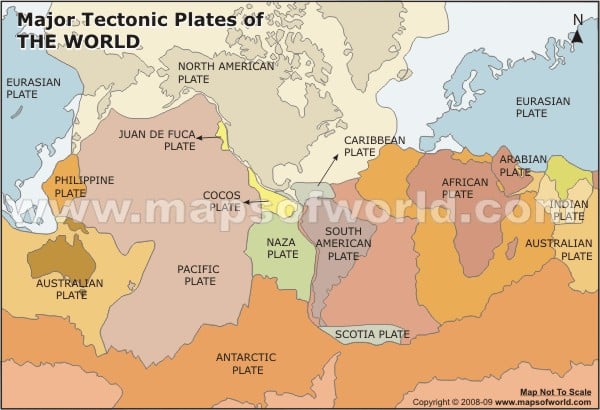Map of the Tectonic Plates of the World
Map of the Tectonic Plates of the World shows the major tectonic plates of the world, including their boundaries

| Description :Map showing major tectonic plates of the world. |
| Disclaimer |
What are Tectonic Plates?
Tectonic plates are the large pieces of the Earth's crust that move around on the planet's surface. These plates can be as large as entire continents or as small as a few hundred miles across. They are made up of both continental and oceanic crust and float on top of the Earth's mantle, which is a layer of hot, viscous rock. There are seven major tectonic plates, and several smaller ones.
Major Tectonic Plates of the World
The seven major tectonic plates are:
- North American Plate
- South American Plate
- African Plate
- Eurasian Plate
- Indo-Australian Plate
- Pacific Plate
- Antarctic Plate
Each of these plates has its own unique characteristics, including size, location, and type of crust. The Pacific Plate, for example, is the largest tectonic plate and covers more than a third of the Earth's surface. The Antarctic Plate is the smallest and is mostly covered in ice.
Plate Boundaries and Interactions
Tectonic plates interact with each other at their boundaries, which can be classified as divergent, convergent, or transform. Divergent boundaries occur when plates move away from each other, creating new crust. Convergent boundaries happen when two plates move towards each other and one is pushed beneath the other in a process called subduction. Transform boundaries occur when two plates slide past each other.
The interactions between tectonic plates result in geological features such as mountain ranges, volcanoes, and earthquakes. The Pacific Ring of Fire, for example, is a region around the Pacific Plate where many of the world's most active volcanoes and earthquakes occur.
Fun Facts and Trivia
- The Pacific Plate is moving northwest at a rate of about 3 inches per year.
- The African Plate is moving northward and is slowly closing up the Mediterranean Sea.
- The Himalayas were formed by the collision of the Indian Plate with the Eurasian Plate.
- The San Andreas Fault in California is an example of a transform boundary.
- The Mid-Atlantic Ridge is a divergent boundary that runs down the center of the Atlantic Ocean.
